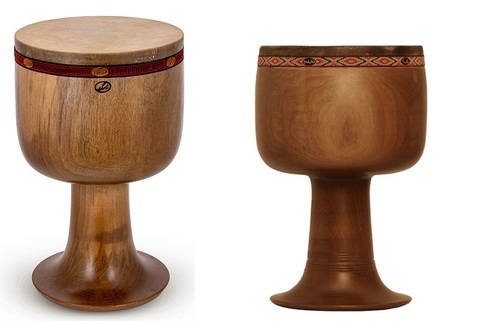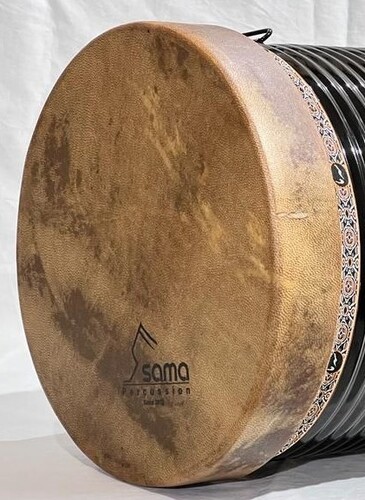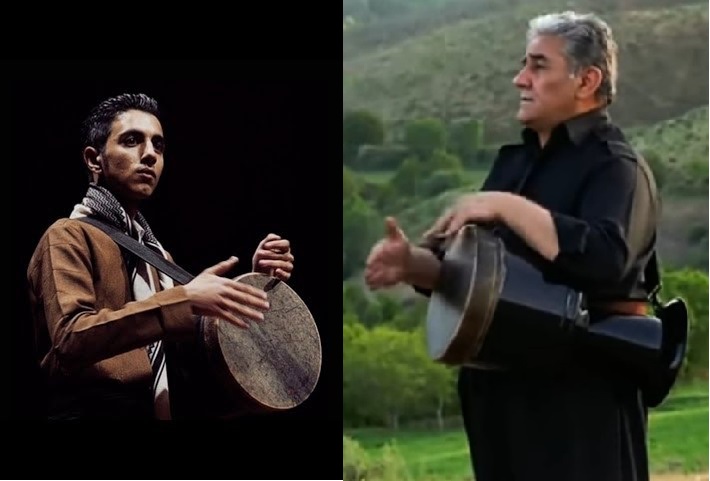- This instrument is known as the Kurdish Zarb or Tabor. Kurdish Zarb belongs to the family of percussion instruments. Percussion instruments are usually covered with skin. Nowadays, plastic is used instead of skin.
- Zarb is made of metal, wood, and red mud. Kurdish Zarb is made of iron or metal sheet in two ways: Mukri and Snayi. The size and style of playing this instrument are the same in the East and South parts of Kurdistan.
Today, the wooden Zarb has changed and it's called Tombak and is used for Iranian instrumental music. Only in Lorestan the Kurdish style of playing the wooden Zarb is the same as the metal Zarb. Mud or tile is not used in Kurdistan due to its heavy weight and easy breakage and is used only in Zurkhaneh (where men exercise traditional sports).
Metal Zarb

wooden Zarb (tombak, damak)

Mud Zarb

Southern musicians play this instrument in the same way as Snayi and Mukriani in the East. In the North and West parts of Kurdistan, Kurdish Zarb is not used in this size and style.
Kurdish percussion consists of the following parts:
1. Large Zark 2. Skin 3. Wooden Kama
4. Kasa 5. Zherkasa 6. Garu 7. Garu Zark 8. Bind 9. Bind ring

1. Large Zark
- The circumference of the Large Zark is 75 to 87 cm.
- The length of Zarb is circled from a metal sheet and folded on the edges for half a centimeter. It is fixed with a hammer and is called Kasa. The top of the Kasa is the Zark of the instrument.
2. Skin
- The skin or leather of goats, geese, and sheep is placed on the large Zark of the instrument.
- Like the skin of the Daff and Duhul should be prepared and then cover the Kama.
3. Kama
- The Kama of Zarb is made of wood.
- Like the Kama of Daff, it is made of willow and walnut trees.
- The width of Kama in Mukriyan is 4 cm and in Sna is 6 cm.
- In general, the Kama of Sna is one and a half to two centimeters wider than that of Mukriyan.
- On the outside of the kasa of Zarb, around the large Zark of the instrument, it is slightly attached to the Kasa by nailing.

4- Kasa (Bowl)
- The length of the Kasa is 20 to 24 cm.
- Snayi zarb is 2 to 3 centimeters shorter than Mukriani zarb.
- Whenever a Zarb bowl is made of delicate metal, the bowl should be made with several waves in the form of lines to work better and not bend.
5. Zherkasa
- The circle under the Kasa is half a centimeter larger than the kasa and the Zarb bowl goes under the bowl.
- Zherkasa is hollowed and deepened with a hammer on a wooden board. The extra half a centimeter of the edges is fixed on each side with a hammer.
- Put a circular hole measuring 8 to 9 centimeters under the bowl.
6 and 7- Garu and Garu Zark
- The length of Garu is 15 to 18 cm.
- A smaller side goes under the bowl and is 8 to 9 cm. The large side becomes the Zark of the Garu, which is 12 to 14 cm.
- A 3 to 5 cm edge is applied to the Garu to hold the instrument. Of course, it should not be too large or wide to affect the sound of the instrument.
8- Laces and lace rings
- The length of the instrument is 45 to 50 cm.
- Two rings are attached to the instrument to wear the instrument.
One is below Kama and on the Kasa and the other is set on the Garu Zark. The lace is set and the musician wears it.
- The Zarb lace is made of leather and cloth.









